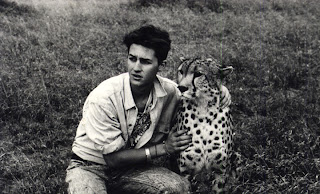For the photographer Corinne Dufka, no photo is worth the life of the correspondent. The film "Dying to tell a story" is about this idea from the perspective of Amy Eldon, who directs the documentary. Amy interview brilliantly photographers from different countries while traveling to Somalia in search of answers about the death of his brother, Daniel Eldon, a photographer for Reuters, killed at age 23 while covering the war in the African country.
Africa was an essential element for Dan's life, who grew up in Kenya next to Amy and family. The director stresses the love that her brother felt for the continent, which increases the sensitivity month to the viewer throughout the production. Even without any formal training in journalism, a passion for photography and love of Africa, who lived intense military conflicts in the early '90s, led Dan to become a correspondent for Reuters.
For photographer Des Wright, something remarkable in the work of a war correspondent's is the personal safety. The integrity of the reporter is the priority for this type of coverage, in the midst of a scenario like Somalia, where, to Wright, the hate was amazing. For him, the photographs conveyed the images, but the smell was really impressive in the midst of so many civilian deaths. In fact, it is more realistic if compared to a photo or story, the emotion felt when witnessing the conflict outweighs any coverage.
Carlos Mavroleon says the camera is able to keep the photographer witnessed lightly insulated from reality. Still, the small distance is not sufficient to fully protect the corresponding of the war scenario and the suffering of local people. The journalist's opinion reiterates the fact that the correspondent is, above all, a sensitive man. Mavroleon, who died in 1998, said feel, not as a human being, but like a vulture over a coverage as the civil war in Somalia.
The British journalist Martin Bell, a veteran of war coverage, defines the joy of being shot and get away as a source of satisfaction. For Bell, who has been injured during the Bosnian war, the journalist is also affected in the conflict and the act of protect themselves with jackets, for example, is a sign of cowardice. The rush is also a dangerous defect for those who dare this kind of work. Anxiety, something that is common for beginners in this job, also affects the veterans before such extreme situations, which is risky.
Mohamed Shaffi, correspondent who witnessed the death of Dan Eldon, clashes with the cruelty of filmmakers during the war in Eritrea, for example. After a village was bombed, wounded children were taken to a house where they rested in the dark. Shaffi turned the lights of the cameras to film them, which caused severe pain in those kids. The experience traumatized Shaffi, which came to be more careful with their own footage, a basic requirement for any correspondent in the area of litigation.
At the end of the documentary, Amy and Shaffi are in Somalia, where the reporter tell the director detailing the circumstances surrounding the death of her brother. Shaffi and Dan were attacked by a mob while covering a UN operation that left 74 civilians dead.Daniel and journalists Hansi Krauss, Anthony Macharia and Hos Mania died in that place.
The film depicts the story of a young man in love for the profession and the people who suffered in the poorest region in the world. "Dying to tell a story" shows the power range of journalism and photography, when executed with talent, but also illustrates the damage caused by the madness of civilians exposed to brutality. Daniel Eldon was a victim of a senseless conflict, risk experienced by all the war correspondents. Dan's life is an example of journalistic engagement, missing in the profession, and the massacre of reporters shows the trivialization of life, found in excess in society.
Photos: www.daneldon.org





